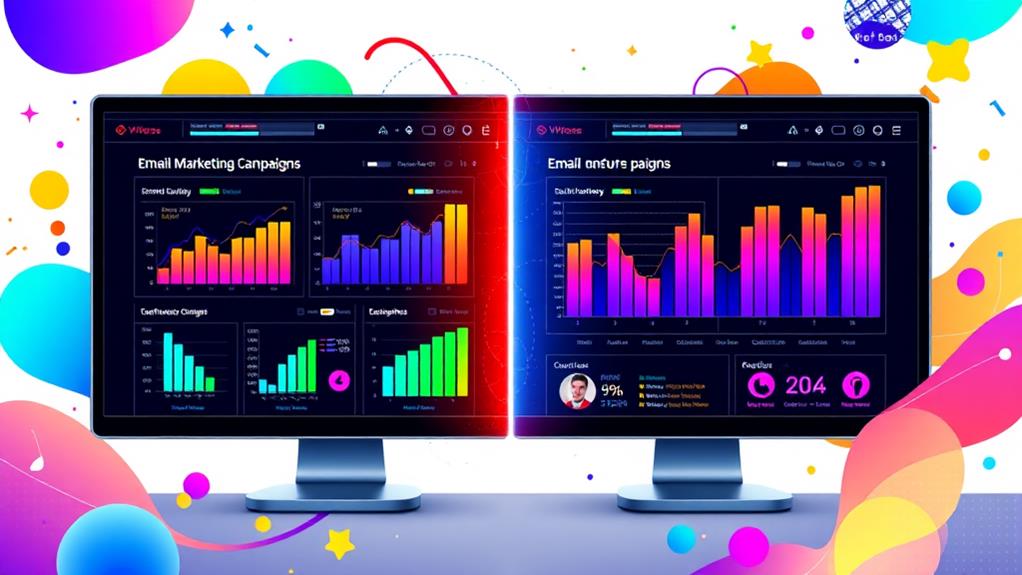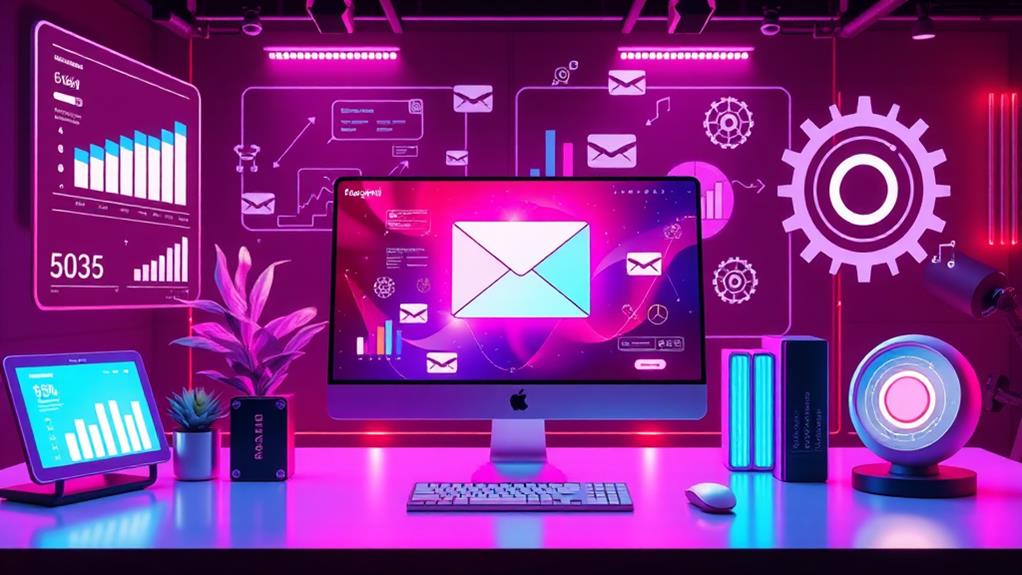In 2024, sending marketing emails on midweek days such as Tuesday and Wednesday proves most effective, with Thursday boasting a 30.6% open rate. Ideal times are mid-morning between 10 AM and 12 PM, and late afternoon from 5 PM to 7 PM. Audience demographics heavily influence timing; Gen Z may engage more during late evenings while professionals aged 25-45 tend to interact during work hours. It's essential to tailor strategies according to geographical time zones and cultural preferences to enhance engagement. Consider strategically aligning your campaigns to these insights for improved performance and greater outreach potential.
Key Takeaways
- Send marketing emails mid-morning (8-10 AM) and late afternoon (4-6 PM) for optimal engagement.
- Tuesday and Thursday are the best days for marketing emails, with Thursday having a 30.6% open rate.
- Avoid sending emails late at night or early morning (9 PM – 7 AM) to increase open rates.
- Segment email lists by time zone to align send times with recipients' local schedules.
- Utilize AI-driven tools to analyze subscriber behavior for personalized optimal send times.
Importance of Email Timing
In the domain of digital marketing, the timing of email dispatches plays a pivotal role in determining the success of a campaign. Effective timing strategies are essential for engagement enhancement, as emails sent during ideal hours such as mid-morning (8 AM – 10 AM) and late afternoon (4 PM – 6 PM) have been shown to yield higher open rates and engagement levels.
This strategic timing guarantees emails reach recipients when they are most likely to interact with the content, thereby increasing the likelihood of conversions.
Moreover, the choice of days greatly impacts performance. Midweek, particularly Tuesday and Thursday, tends to maximize open rates, with Thursday averaging a 30.6% open rate. These insights highlight the necessity for marketers to meticulously plan their email schedules to align with recipient availability and engagement patterns.
Audience demographics also influence timing strategies. Younger audiences may engage more frequently with emails late at night, while older demographics exhibit a preference for early to mid-morning engagements.
Continuous testing, such as A/B testing and analysis of historical data, enables marketers to refine these strategies, guaranteeing emails are dispatched when recipients are most receptive, enhancing both visibility and conversion potential.
Key Performance Metrics
Understanding the ideal timing for sending marketing emails is only part of the equation. Equally vital is measuring key performance metrics to gauge campaign effectiveness.
Open rates, which indicate the percentage of recipients who open an email, shed light on the appeal of subject lines and the timing of delivery. Significantly, open rates are often higher on Tuesdays and Thursdays, guiding strategic decisions.
Meanwhile, click-through rates (CTR) capture engagement by evaluating how many recipients click on links compared to the total emails delivered. This metric is essential in evaluating the compelling nature of content.
To further analyze engagement, the click-to-open rate (CTOR) is used to determine how effectively an email converts opens into clicks, emphasizing the persuasiveness of the email content.
With continuous monitoring of these metrics, marketers can:
- Refine email strategies by adapting send times and content based on observed patterns.
- Enhance overall engagement and conversion rates through data-driven adjustments.
- Align campaigns with evolving trends and audience behaviors for sustained impact.
- Leverage insights to optimize both timing and content, ensuring marketing efforts are both targeted and effective.
Regular analysis of these metrics is essential for maximizing email marketing success.
Understanding Audience Demographics
Audience demographics play a pivotal role in optimizing email marketing strategies, as age-specific habits reveal that younger recipients often engage with emails during late-night hours, whereas older individuals show a preference for mid-morning interactions.
Additionally, the professional lifestyle of recipients is essential; for instance, traditional 9-5 employees are more likely to check emails during office hours, while freelancers exhibit more flexible email-checking patterns.
Moreover, for businesses targeting a geographically diverse audience, adjusting email send times according to time zone differences can greatly enhance engagement rates, ensuring emails are received during peak activity periods.
Age-Specific Email Habits
Recognizing the distinctive email habits of different age demographics is essential for optimizing marketing strategies. By aligning email send times with the unique behaviors of each age group, marketers can greatly enhance engagement rates.
For instance, Gen Z preferences highlight a tendency to check emails later in the evening, typically from 9 PM to midnight, making weekend or Saturday deployments highly effective. Conversely, Baby Boomer habits show a proclivity for mid-morning interactions, particularly between 9 AM and 11 AM on Tuesdays, aligning with their routine schedules.
Understanding these nuanced differences can guide strategic decisions:
- Younger audiences: Millennials and Gen Z frequently engage during leisure time, leading to higher open rates on Sunday evenings.
- Structured professionals: Those aged 25-45 are more likely to engage during work hours, particularly between 10 AM and 12 PM.
- Weekend focus: Recipients aged 18-34 show increased engagement on weekends, optimizing Saturday and Sunday sends.
- Tailored timings: Segmenting email lists by age can boost open rates by aligning with specific habits, enhancing marketing efficacy.
Incorporating these insights into email marketing strategies can drive improved open and click-through rates, achieving more effective audience engagement.
Professional Lifestyle Influence
Leveraging insights into professional lifestyle influences is essential for crafting effective email marketing strategies. Understanding the professional routines of diverse audience segments can optimize engagement patterns and greatly enhance campaign effectiveness.
Younger professionals, who often check emails late at night, contrast with older demographics, favoring mid-morning. These insights highlight the necessity to segment audiences by age and preferred email-checking times to maximize engagement.
Professionals adhering to traditional 9-5 schedules typically engage with emails during work hours. Conversely, freelancers exhibit more flexible habits, necessitating a tailored approach to email timing. This distinction underscores the importance of understanding professional routines for targeting.
For B2B audiences, midweek emails generally yield higher open and click-through rates, possibly due to structured professional routines, while B2C campaigns can benefit from more flexible timing aligned with consumer lifestyle patterns.
Geographical Timing Variations
Effective email marketing requires a strategic approach to geographical timing variations, as demographic insights reveal notable differences in email engagement across time zones.
Understanding audience demographics is pivotal, as varying regional preferences can greatly influence the success of email campaigns. Younger audiences, for example, are often night owls, checking emails late at night, whereas older demographics favor mid-morning engagement.
Recognizing these time zone differences allows marketers to tailor their email timing strategies effectively.
- Time Zone Differences: Align email send times with recipient time zones to maximize open rates.
- Regional Preferences: Consider cultural and regional nuances to enhance engagement, especially on weekends.
- Professional Schedules: Target 9-5 workers during work hours and accommodate freelancers' flexible routines.
- Segmented Lists: Use demographic insights to segment email lists, optimizing for higher engagement and conversion rates.
Best Sending Times
Identifying the ideal times for sending marketing emails is essential for maximizing engagement and open rates. To enhance email frequency and content relevance, marketers should consider sending emails on Tuesday and Wednesday, which are traditionally high-engagement days.
Thursday stands out with the highest open rates, approximately 30.6%, making it a strategic choice for critical campaigns. Timing is equally important; emails dispatched between 10 AM and 12 PM, and again from 5 PM to 7 PM, align with periods when recipients are most likely checking their inboxes and are receptive to new content.
Conversely, sending emails late at night or in the early morning hours, specifically between 9 PM and 7 AM, should be avoided due to historically low engagement rates. As recipients prepare for the weekend, emails sent on Fridays around lunchtime can be particularly effective, capturing their attention at a time when they are winding down from the workweek.
For achieving the best results, continuous A/B testing and demographic analysis are recommended. This approach enables marketers to fine-tune their strategies, ensuring emails are not only sent at prime times but also reach audiences when they are most likely to engage.
Strategies for Improvement
Building upon the understanding of ideal email sending times, marketers can further enhance their strategies by implementing targeted improvements. A/B testing emerges as a crucial tool, allowing marketers to experiment with various send times, uncovering the best performance for audience segments. Data indicates that midweek mornings, particularly from Tuesday to Thursday, often yield higher engagement rates.
To capitalize on this, marketers should consider leveraging personalization techniques and engagement strategies to tailor their approach effectively.
Key strategies for improving email timing include:
- Segmenting email lists: By categorizing recipients based on demographics, marketers can adjust timing strategies, ensuring emails reach inboxes when engagement is most probable.
- Analyzing historical data: Exploring past campaign performance can reveal patterns, guiding decisions to improve open and click-through rates.
- Utilizing automation tools: These tools adapt sending times based on subscriber behavior, enhancing personalization by targeting moments when recipients are most active.
- Adjusting strategies regularly: Continuously refining approaches based on audience trends and engagement metrics sustains the effectiveness of email marketing efforts.
Such data-driven and strategic enhancements pave the way for more personalized and engaging email campaigns, fostering stronger connections with target audiences and maximizing overall marketing impact.
Optimal Days for Email Campaigns
Understanding the ideal days for launching email campaigns is essential for maximizing engagement and open rates. Data indicates that midweek days, specifically Tuesday and Wednesday, consistently outperform other days regarding open rates. This trend highlights the importance of strategically planning email frequency to align with peak recipient activity. With a notable open rate of approximately 30.6%, Thursday emerges as another ideal day, particularly for campaigns focused on content relevance that require a slightly different engagement strategy. Conversely, Mondays should generally be avoided due to lower engagement levels, as recipients often focus on acclimating to their workweek tasks.
Below is a table summarizing open rates by day:
| Day | Open Rate (%) | Recommendation |
|---|---|---|
| Tuesday | High | Ideal for engagement |
| Wednesday | High | Consistent performance |
| Thursday | 30.6 | Peak engagement day |
The effectiveness of emails sent on weekends varies, being more suitable for specific B2C audiences. However, weekday emails remain more effective overall. Timely dispatches between 10 AM and 12 PM on recommended days further enhance visibility, thereby amplifying the impact of content relevance. Strategically leveraging these insights allows marketers to enhance their email campaigns, ensuring maximum subscriber interaction and response.
Factors Influencing Engagement
A multitude of factors influence email engagement, necessitating a strategic approach tailored to audience demographics and professional habits. Understanding engagement psychology is essential in enhancing email campaigns.
For instance, younger subscribers tend to check emails late at night, whereas older demographics exhibit higher engagement mid-morning. In addition, timing preferences diverge across professions; traditional 9-5 workers primarily engage during work hours, while freelancers display more flexible habits. This necessitates a nuanced strategy that considers these variances.
Key insights include:
- Demographic Preferences: Younger audiences favor late-night engagement, while older demographics peak mid-morning.
- Professional Habits: 9-5 employees engage primarily during work hours; freelancers have diverse engagement times.
- Weekday Effectiveness: Mid-week days, especially Thursday with a 30.6% open rate, are ideal for email sends.
- Cultural and Geographical Differences: Time zone considerations are vital for global audience engagement.
Content relevance is equally important. Tailoring emails to align with audience interests and needs enhances engagement.
The prime window for sending emails, typically between 10 AM and 12 PM, with secondary peaks from 5 PM to 7 PM, should be leveraged to maximize impact.
Tools for Timing Optimization
Maximizing email marketing success hinges on precise timing strategies, as previously explored. Effective email scheduling is essential for enhancing engagement rates, and tools designed for timing enhancement are indispensable in this process.
MailerLite's Smart sending feature exemplifies this, utilizing historical data to automatically pinpoint ideal send times for each subscriber. This personalized approach boosts engagement by aligning with individual user behavior.
Twilio SendGrid enhances this capability with its robust analytics, allowing marketers to perform detailed send time analysis. These insights help in refining email scheduling strategies through thorough performance assessments.
Additionally, A/B testing features in various email marketing platforms provide a methodical approach to compare different send times. By evaluating real engagement data, marketers can iterate and improve their strategies effectively.
Automation tools further refine timing enhancement by segmenting email lists based on demographics and behavior, which enables tailored scheduling for specific audience groups.
The integration of AI-driven tools takes this a step further by analyzing subscriber behavior patterns. These tools recommend personalized send times, ultimately improving open and click-through rates by ensuring emails reach subscribers at their most receptive moments.
This strategic approach is key to elevating marketing performance.
Frequently Asked Questions
What Days Are Best for Marketing Emails?
The ideal days for maximizing email engagement are Tuesdays, Wednesdays, and Thursdays. These days align with audience preferences, yielding higher open rates. Strategic timing further enhances effectiveness, particularly during mid-morning and early evening hours.
What Is the Best Time to Send an Email on a Thursday 2024?
The ideal time for email engagement on Thursdays in 2024 is between 10 AM and 12 PM, aligning with audience behavior patterns. This timing leverages peak open rates, enhancing strategic communication effectiveness in both B2B and B2C sectors.
Is Saturday a Good Day for Email Marketing?
Saturday engagement for email marketing is generally lower, aligning with weekend trends of decreased activity. While some consumer segments, particularly in leisure sectors, may respond well, Saturdays remain a riskier choice for broader, strategic campaigns.
What Is the Best Time for B2B Email Marketing?
Determining the ideal time for B2B email marketing requires analyzing email open rates and audience segmentation. Strategically, sending emails between 8 AM and 10 AM on midweek days maximizes engagement as recipients begin their workday activities.
Conclusion
To sum up, determining the best days and times for sending marketing emails in 2024 necessitates a data-driven approach that considers key performance metrics, audience demographics, and engagement factors. Strategic timing, complemented by advanced tools for optimization, enhances email campaign effectiveness. Empirical evidence suggests that aligning email dispatch with audience behaviors greatly boosts open and click-through rates. Continuous analysis and adaptation of strategies are essential to maintaining competitive advantage in the evolving digital marketing landscape.




